On any given day, your nonprofit has a lengthy to-do list. There are programs to run, fundraisers to plan, thank-you messages to send, and so much more to accomplish. That’s why volunteers are so important to your long-term success. By lending their time and skills to your nonprofit, they empower you to make the most of your resources and amplify your impact on the community.
But how do you cultivate a close-knit band of passionate volunteers for your cause? Once you’ve put in the effort to recruit these key individuals, it’s essential to develop strategies for retaining them.
In this guide, we’ll answer basic questions about volunteer retention and cover the best strategies to keep your volunteers coming back:
- FAQs About Volunteer Retention
- Top Volunteer Retention Strategies
- Essential Tools for Volunteer Retention
Independent Sector estimates that each volunteer hour in the U.S. is worth $31.80. To tap into the full benefits of volunteers, you’ll need to build an engaging program that encourages their involvement year after year. Let’s start by walking through some volunteer retention basics.

FAQs About Volunteer Retention
Before you begin making improvements to your volunteer program, explore these frequently asked questions to inform your approach:
What is volunteer retention?
Your employees are paid members of your nonprofit who carry out daily tasks to fulfill your mission. At the same time, your donors contribute financial gifts of varying sizes to power your work. Volunteers combine these two roles, in a way, by contributing their time, skills, and energy toward your goals.
For example, an animal shelter might enlist volunteers to clean kennels, walk dogs, and help visitors fill out adoption paperwork. In doing so, the nonprofit frees up more of its staff resources to commit to other mission-critical tasks.
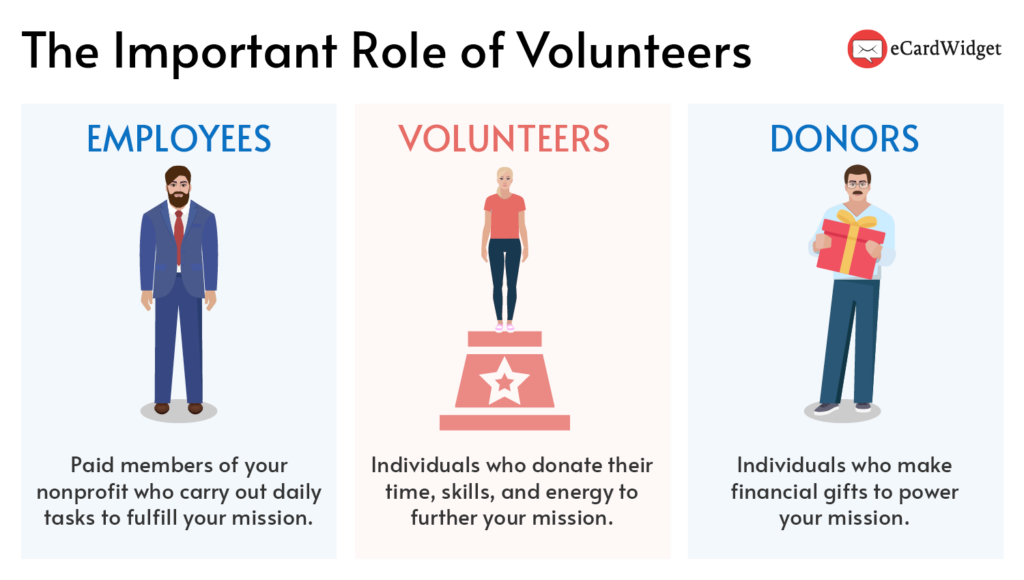
Volunteer retention refers to your nonprofit’s ability to keep its volunteers engaged in its various activities year after year.
Many people choose to become volunteers because they’re interested in participating in your nonprofit’s impact. However, numerous reasons may lead them to pause or end their involvement. For instance, they may feel:
- Unappreciated for their contributions.
- Ineffective in making a real difference in their communities.
- Burned out from their commitments.
- Too busy to find time to volunteer.
- Unprepared or overwhelmed by their roles.
While no two volunteers will have the same experience with your nonprofit, taking the steps to engage and appreciate them as individuals can go a long way toward retaining their involvement.
Why is it important to retain volunteers?
Volunteer recruitment is the number one challenge reported by 33% of surveyed volunteer managers. Whether you’re looking to fill skilled positions or simply in need of enough in-person volunteers to facilitate an upcoming event, it can require significant energy and resources to attract the right individuals to your nonprofit.
Establishing a solid plan for volunteer retention ensures that the fruits of your efforts don’t disappear after just one or two commitments. Reliable, returning volunteers have already gone through your orientation and training process. They’re familiar with your nonprofit’s mission and have a better understanding of how they can contribute to your goals. Plus, they may be able to bring additional funding to your nonprofit through volunteer grants.
40% of Fortune 500 companies have a volunteer grant program, in which they make gifts to nonprofits with which their employees regularly volunteer. These programs typically require employees to contribute a minimum number of hours to qualify, so you’ll have a better chance of securing these grants with volunteers who consistently respond to your volunteer opportunities throughout the year.
How do you measure volunteer retention?
To calculate your volunteer retention rate, divide your number of returning volunteers by the total number of volunteers from the previous year, then multiply this number by 100. To better understand this formula, let’s break down the two main elements:
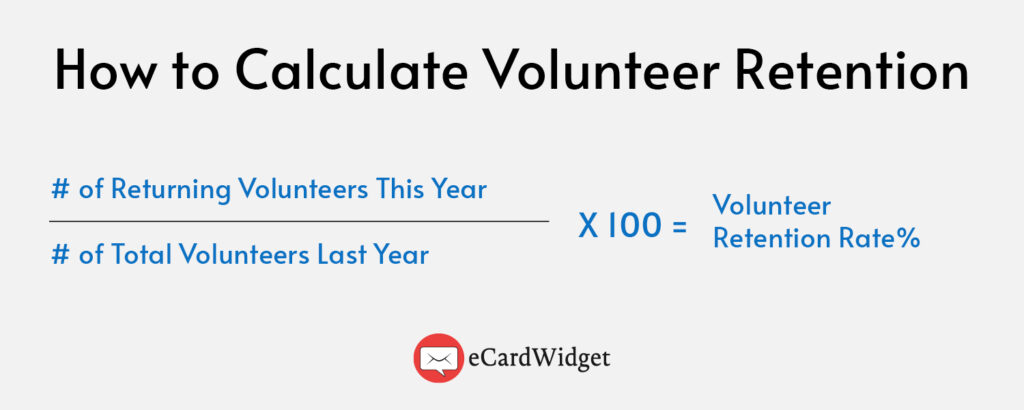
- Returning volunteers. These are the volunteers who were consistently involved with your nonprofit throughout the previous year and are still involved this year.
- Total volunteers. These are all the volunteers who supported your nonprofit during the previous year.
First, choose a start and end date. For example, you might decide on January 1st for your start date and December 31st for your end date. Let’s say you had a total number of 1,000 volunteers in the previous year and 650 returned to continue their involvement this year. You would divide 650 by 1,000 and multiply by 100 to calculate a volunteer retention rate of 65%.
For an accurate measurement of your volunteer retention, remember to continually organize and update your database to exclude inactive volunteers from your calculations.
12 Top Volunteer Retention Strategies
Once you’ve calculated your nonprofit’s volunteer retention rate, it’s time to figure out how to improve it. Consider implementing these tried-and-true strategies:
1. Use eCards.
While there are numerous ways to reach out to your volunteers, they’re much more likely to appreciate messages that you’ve put time and thought into, rather than a generic email. That’s why eCardWidget is the premier communication tool for all types of retention.
eCards are fully customizable, digital greeting cards that you can send via email, social media, or text messaging. There are endless possibilities for design and messaging. Your nonprofit can produce its own eCards in just four simple steps:
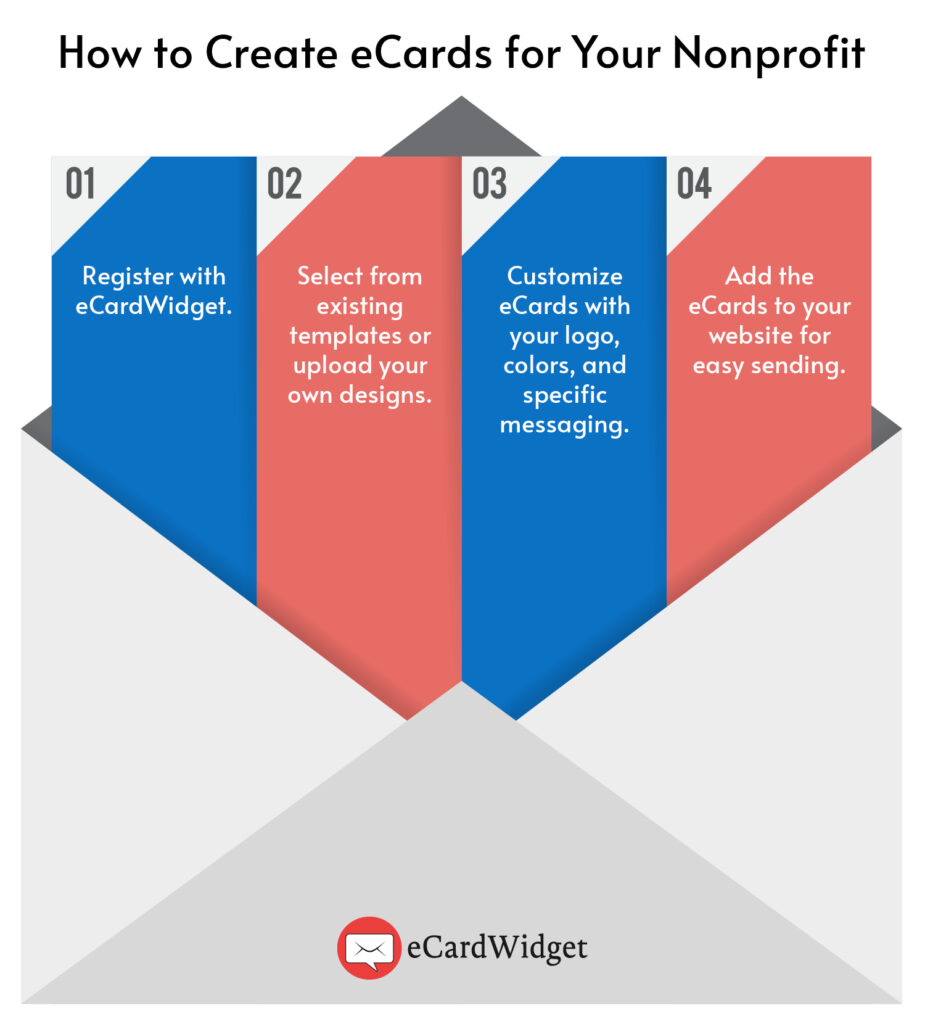
- Register with eCardWidget.
- Select from existing templates or upload your own designs.
- Customize your eCards with your logo, colors, and specific messaging.
- Add the eCards to your website for easy sending.
By embedding the eCards in your website, you can allow multiple people to access and send them. Your nonprofit’s leaders can send them to volunteers, volunteers can send them to recognize their peers, and donors can send them to spread awareness for your cause.
Here are a few impactful ways you can incorporate eCards into your volunteer retention strategy:
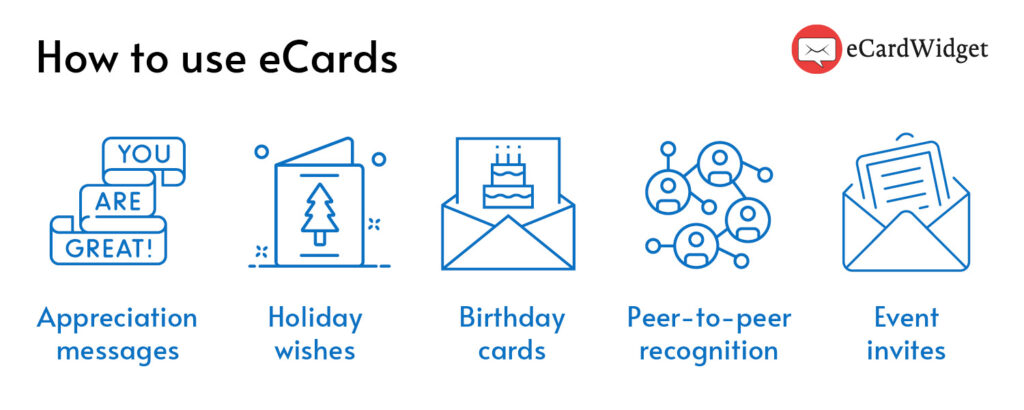
- Appreciation messages. Just as you’d quickly thank a friend who gives you a gift, you should also express your appreciation for volunteers in a timely manner. Transform your thank-you letters into eye-catching digital cards that recognize each individual for their specific contributions. The card will pop up in the volunteer’s inbox in seconds, making them feel prioritized and appreciated.
- Holiday wishes. Throughout the year, your nonprofit will have opportunities to show volunteers that you value them and their continued support. Many holidays, such as Thanksgiving or New Year’s Eve, remind people how fortunate they are and encourage them to give back to their communities. Send a digital holiday card to remind volunteers of the importance of getting involved.
- Birthday cards. Have you ever spent 30 minutes at the store looking for the right birthday card to buy a friend? The ability to fully customize eCards makes them a great solution for showing volunteers that you not only remember their birthdays but also key details about them that you’re able to mention in the card. The design, contents, and even animations are all up to you!
- Peer-to-peer recognition. Your nonprofit is a team—every donor, board member, employee, and volunteer works together to make your mission a reality. Allow them to share their appreciation for their peers by branding eCards to your nonprofit and making them accessible on your website or volunteer portal.
- Event invites. Retention is all about getting volunteers to continue their involvement, so invite them to new opportunities with eCards! Send invitations to your current volunteers with specific details about upcoming events to secure their support.
To learn more about how your nonprofit can use eCardWidget to strengthen its community of volunteers, donors, and employees, check out our brief video overview:
As the video demonstrates, eCardWidget provides your nonprofit with absolute freedom when it comes to creating branded, attention-grabbing eCards to send to your audiences. It’s a tool you can use for many purposes for years to come.

2. Facilitate volunteer sign-ups.
Volunteer retention begins at the very start of their experience with your nonprofit. Therefore, it’s important to make a strong first impression by promoting engaging roles and offering a streamlined sign-up process.
Attract motivated volunteers to your nonprofit through:
- Your website. Create a dedicated page on your website for sharing information about your upcoming volunteer opportunities, along with inspiring pictures of your volunteers in action. By applying for the Google Ad Grant, you can receive $10,000 a month to spend on Google Ads credits and promote your volunteer page to internet users searching for topics related to your cause.
- Social media. Design eye-catching social media posts that direct your followers to new volunteer openings on your website. Use language that stirs up a sense of urgency and feature images that convey the impact that volunteer support can have on those you serve.
- Direct messages. For those of your supporters who have opted in to receive text messages from your nonprofit, appeal to them directly by texting them details about volunteer opportunities they may be interested in.
Furthermore, your volunteer registration page should be mobile-responsive, so those who are interested can fill it out on whichever device they prefer. Since many people enjoy volunteering with their friends and family members, consider adding options that make it easier for them to sign up as a group.
3. Create a smooth onboarding and training process.
Set your volunteers up for success by providing them with the background information and training they need to excel in their roles. Host a virtual or in-person orientation that covers your nonprofit’s mission and history, walks through specific volunteer responsibilities, and designates a point of contact to answer any additional questions that may come up later.
Following the orientation, provide a variety of training resources, such as:
- Mentoring
- Roleplaying activities
- Interactive quizzes
- Q&A sessions
Volunteers who feel prepared to take on their responsibilities are much more likely to have a memorable and fulfilling experience that encourages them to sign up for future opportunities.
4. Learn about your volunteers.
Your nonprofit’s current and prospective volunteers each have unique interests, preferences, and skills. By collecting more information about them, you’ll be able to set up opportunities that are most likely to resonate with them.
Use your volunteer registration form to ask for basic details such as:
- Age
- Location
- Employment information (to identify volunteer grants, VTO programs, and more)
- Occupation
- Hobbies and interests
- Motivations for volunteering
Additionally, keep track of volunteer engagement with your existing opportunities. You might determine that many of your volunteers are interested in contributing virtually and decide to plan more virtual volunteering activities. Overall, some of the top skills that volunteers enjoy utilizing involve caring for people and exercising their creativity.
5. Segment your volunteer communications.
To nurture meaningful, lasting relationships with volunteers, you’ll need to demonstrate that you value them as individuals, rather than just a nameless group of supporters. By segmenting your volunteers, you can tailor your communications and craft messages that they’re more likely to read and respond to.
Consider segmenting your volunteers by:
- Skills
- Interests
- Location
- Availability
- Communication preference
According to AmeriCorps, Baby Boomers and Generation X have the highest formal volunteering rates in the U.S. With this in mind, you might appeal to more members of these generations by sharing volunteer opportunities through their preferred communication channels, such as email or even phone calls.
6. Add flexibility to volunteer opportunities.
Some of your loyal volunteers may fall inactive not because they’re no longer invested in your nonprofit’s success, but because changes in their life circumstances have made it more challenging to get involved.
Help these passionate supporters stick around by:
- Using volunteer management software that allows volunteers to self-schedule their shifts based on their preferences and availability.
- Providing a range of virtual volunteering options for those who may find it more convenient to volunteer from home.
- Arranging carpools to minimize transportation costs.
- Creating micro-volunteering opportunities that are low-commitment, such as making thank-you phone calls or proofreading fundraising letters.
Furthermore, ensure that your volunteer activities are inclusive by building accessible sign-up forms and including a field that allows people to specify whether they need accommodations to participate.
7. Highlight the benefits of volunteering.
Remember that volunteering, like any other relationship with your nonprofit, should be mutually beneficial. Think about the common reasons why your volunteers get involved, then emphasize those benefits in your opportunities and communications.
For example, volunteering can bring benefits such as:
- Leadership skill development. Many people are interested in volunteering because they’d like to practice important leadership skills such as problem-solving, communication, and teamwork. Help your volunteers achieve this goal by allowing them to support your event planning activities, lead new volunteer orientation sessions, and more.
- Career training. Especially for recent college graduates and young professionals, volunteering can provide essential work experience that they can list on their resumes and mention during job interviews. Volunteer opportunities related to specific skills such as graphic design, web development, and social media management can be enticing for prospective volunteers interested in honing their talents.
- Improved health. Volunteers over the age of 60 report better physical health and lower rates of depression and anxiety. Encourage your volunteers to look after their health by participating in events that brighten their mood and allow them to get active, such as community cleanups.
- New connections. Volunteering is an excellent way to meet like-minded people who share similar interests and values. Plan a variety of in-person, hybrid, and virtual opportunities so that everyone has a chance to feel like a part of your nonprofit’s community.
By helping your volunteers see and tap into the benefits they’ll receive from volunteering, you’ll be able to forge partnerships that help both parties thrive.
8. Practice thoughtful volunteer appreciation.
Your nonprofit couldn’t accomplish all of its important work without the contributions of your volunteers. Make sure they know just how much you value them by brainstorming several methods for expressing your appreciation.
In addition to sending a personalized thank-you eCard after a volunteer’s participation, you can:
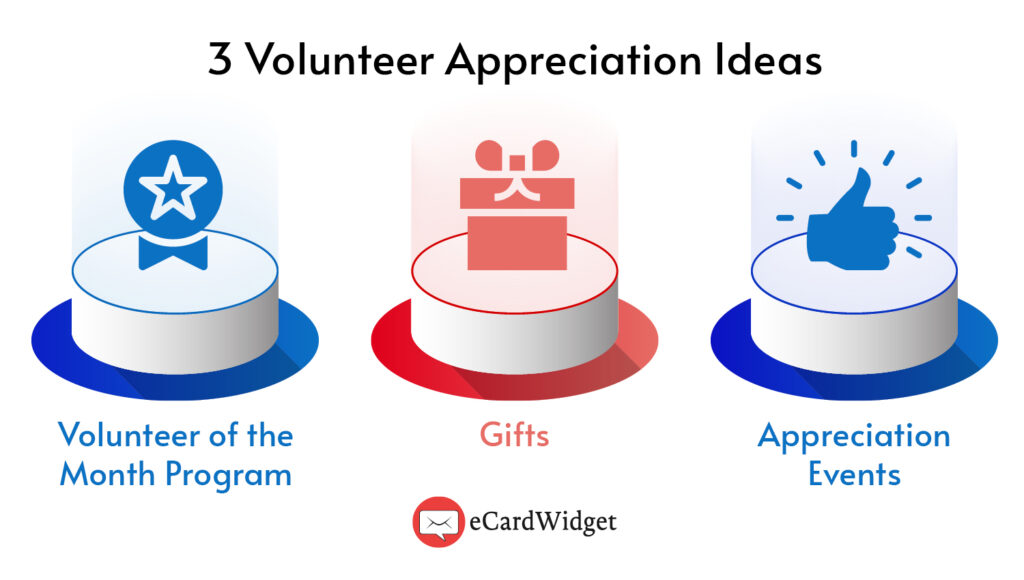
- Start a Volunteer of the Month program. Recognize specific volunteers who go above and beyond in service of your nonprofit by spotlighting them on social media. With their permission, include their name and photo alongside a summary of their impact and a quote conveying why they were inspired to get involved.
- Send gifts. Bring volunteers closer to your nonprofit by awarding them with gifts like branded merchandise. Whether you present them with a t-shirt or stickers with your logo on it, your volunteers can proudly display their connection to your organization while spreading more awareness about your cause.
- Host an appreciation event. Celebrate your volunteers by planning an event in their honor. Consider livening up the occasion with catered meals, entertainment, and highlights of everything your volunteers have accomplished.
Ultimately, developing a culture of gratitude at your nonprofit will create an environment in which both your volunteers and employees are happy to continue working day after day.
9. Survey your volunteers.
Volunteer surveys are an effective tool for demonstrating your nonprofit’s commitment to providing engaging and rewarding experiences for its volunteers. Plus, they can unlock new insights for refining your volunteer engagement and retention strategies.
In these surveys, you can ask questions such as:
- What types of volunteer activities are you most interested in?
- How would you rate your latest volunteer experience?
- How likely are you to sign up for another volunteer opportunity?
- What improvements, if any, would you like to see in our volunteer program?
- Are there any other roles or opportunities within our nonprofit that you’re interested in?
Once you’ve collected your volunteer feedback, sift through all the survey responses to identify common themes or ideas. Identify reasonable improvements and share these changes so volunteers know that you’re actually acting on their input.
10. Promote additional ways to get involved.
Your volunteers are bound to go through life changes that may increase or decrease their ability to volunteer with your nonprofit. However, that doesn’t mean they have to disconnect completely, or that they won’t be able to sign up for opportunities in the future.
Encourage volunteers to stay invested in your nonprofit by sharing other ways they can get involved, including:
- Making a gift
- Becoming a peer-to-peer fundraiser
- Attending an event
- Joining your social media community
- Signing a petition
Remember to emphasize the impact that your supporters can have on the community, whether they’re volunteering or launching a birthday fundraiser on your nonprofit’s behalf. In doing so, you’ll make them feel more empowered as a key contributor to your mission.
11. Share job opportunities.
The main goal of volunteer retention is to show your nonprofit’s current volunteers that they have a future at your organization. Some volunteers will be especially interested in long-term involvement through a full-time position.
When a position opens up at your nonprofit, look to your volunteers first. Prioritizing their applications is an impactful way to reward them for all their dedication. Plus, knowing that they can access promising career opportunities can inspire your volunteers to contribute more consistently and find other ways to deepen their involvement, such as participating in your advocacy efforts.
Incorporate volunteer retention into your hiring cycle with these steps:
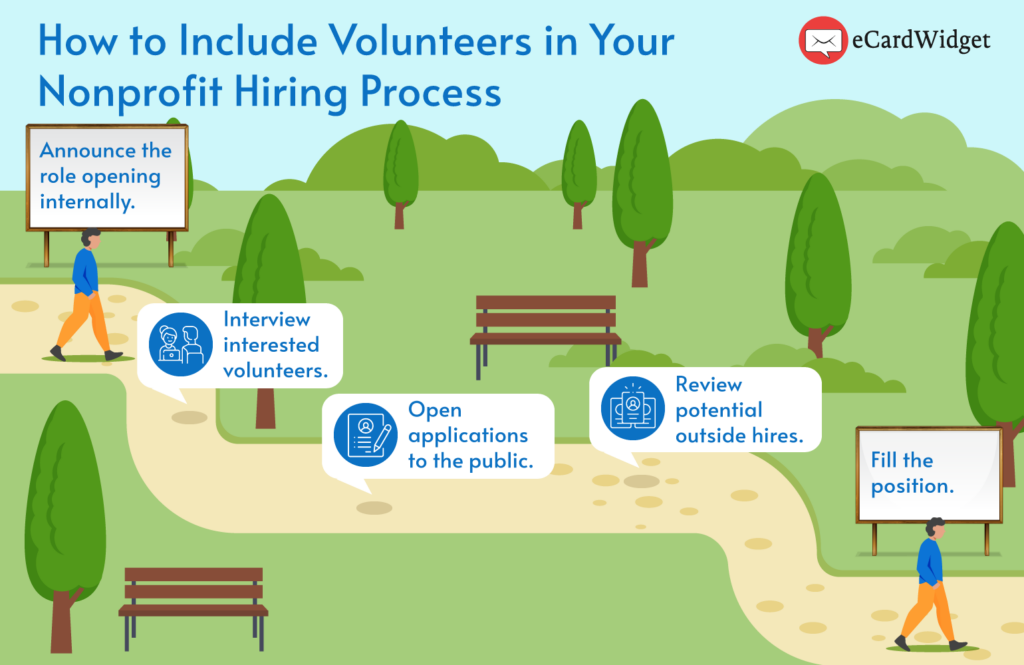
- Announce the role opening internally.
- Interview interested volunteers.
- Open applications to the public.
- Review potential outside hires.
- Fill the position.
Promoting volunteers into full-time staff members allows you to build highly dedicated and engaged teams. Plus, their experience with day-to-day volunteer tasks means that they’re already familiar with your nonprofit’s operations and values, so they have a pre-existing understanding of how they can best contribute to your goals.
12. Promote corporate volunteerism.
Promoting corporate volunteerism is an effective way to scale up the impact of supporters’ time on your mission, thus driving retention as well.
Fortunately, organizing unique volunteer opportunities tailored to specific corporate groups can foster a sense of camaraderie among employees and staff. These events can be designed to align with the company’s values and interests, making them relevant and appealing to the employees, too.
At the same time, you don’t want to overlook the opportunities presented by individual employee volunteerism, either. Programs like volunteer grants and volunteer time off compensate nonprofits and their supporters for time.
Here’s how we recommend promoting volunteerism to your audience for the best results:
- Embedding a corporate volunteer database on your Volunteers page
- Following up with volunteer grant-eligible or VTO-eligible individuals after they volunteer with your organization
- Encouraging existing volunteers to organize team volunteer activities with their colleagues
- Share information about corporate volunteer opportunities on social media, in email newsletters, and more
- Leverage existing employee interest to tailor your outreach to prospective corporate partners
When companies see the positive impact on team building, employee morale, and community engagement, they’ll be more likely to support and promote volunteer opportunities to their staff.
Essential Tools for Volunteer Retention
There are several tools that your nonprofit can use to streamline its volunteer retention efforts. The following resources can significantly improve your program:
- eCards. The versatility of eCards allows you to use them for any type of volunteer communication, whether you’re sending a thank-you note or encouraging them to sign up for an upcoming opportunity. Plus, they’re much more likely to stand out in your volunteers’ inboxes and make a lasting impression.
- Volunteer management software. To retain volunteers, you need to provide them with smooth, fulfilling experiences. With a volunteer management solution, you can make it easy to schedule shifts, share important details, and track attendance.
- Event tools. Equip your event volunteers with tools that will help them carry out their responsibilities. For example, if you’ve recruited volunteers to manage check-in at your next charity auction, consider adopting auction management software to streamline the process.
- Volunteer handbook. Assemble a volunteer handbook that clearly outlines volunteer roles, responsibilities, and expectations. This way, volunteers have everything they need to succeed during their next shift.
- Volunteer grant database. Make it easy to uncover volunteer grant opportunities (i.e., double the impact of volunteer support!). Equip your supporters with an intuitive and comprehensive volunteer grant database like Double the Donation to do so!
Think about your nonprofit’s budget and specific needs when evaluating volunteer retention tools to invest in. If you’re looking for a volunteer management solution, read online reviews and request demos to find the best fit for your volunteer program needs.
Wrapping Up: Year-Round Volunteer Engagement and Retention
Retaining volunteers is critical to building a powerful community that propels your nonprofit’s mission forward. As you implement these volunteer retention strategies, keep an eye on metrics such as your retention rate and the number of hours served to evaluate your progress. By maintaining an improvement mindset, you’ll set your nonprofit up to retain more volunteers year after year.
For more information on how to strengthen your nonprofit’s community and secure more support for your mission, check out these additional resources:
- How to Motivate Employees: 12 Easy Ways to Uplift Workers. Help your nonprofit employees put in their best effort every day by exploring these easy ways to inspire them.
- How to Thank Donors: 22 Sincere Ideas To Win Donors’ Hearts. Make your donor relationships last by incorporating these tried-and-true appreciation ideas into your strategy.
- Board Member Appreciation: A Complete Guide for Nonprofits. Your board members fulfill many essential responsibilities that ensure your nonprofit’s long-term success. Learn how to thank them for their efforts in this guide.



